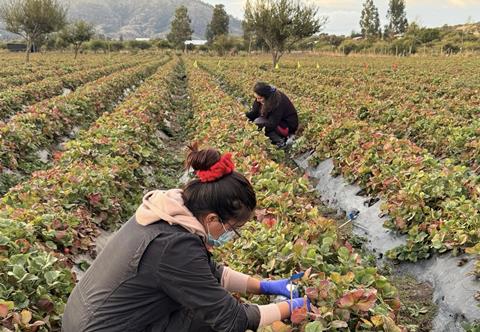Project centres on an innovative biological preservation system based on improved native yeasts
Chile’s Agricultural Research Institute (Inia) has announced that it has completed the first season of field trials for an innovative project that seeks to extend the shelf-life of strawberries through the use of improved native yeasts capable of producing compounds that delay ripening and decomposition.

The tests were conducted in San Pedro de Melipilla, in collaboration with local farmers associated with Agrofrutillas San Pedro, and the research will now continue with laboratory trials.
The project centres on an innovative biological preservation system based on improved native yeasts developed by group of researchers to extend the postharvest shelf-life of strawberries. The studies analysed the effect of the system on both pre-harvest fruit, during ripening on the vine, and on harvested fruit, evaluating quality parameters and shelf-life.
The project, funded by the National Agency for Research and Development (Anid) through its Applied Research Subdirectorate (SIA), is being implemented in collaboration with the University of Santiago and AgroQ-Tral. Its purpose is to offer high-value biological solutions capable of maintaining fruit quality and freshness for longer, reducing losses and contributing to more sustainable production.
At its heart lies in the use of native yeasts of the Saccharomyces cerevisiae species, microorganisms widely known in oenology and baking. In this case, these microorganisms are selected and optimised to produce a natural gas transmitter. This compound stands out for its antimicrobial properties and its ability to regulate fruit ripening and senescence.
Dr Sebastián Molinett Soto, researcher at Inia La Cruz and project director, said the biological preservation system aims to reduce postharvest losses in delicate fruits such as strawberries.
“We work with yeasts isolated from winemaking environments, subjected to genetic improvement through conventional crossbreeding, to obtain a gas capable of extending the fruit’s shelf-life, especially in the face of the challenges of fresh marketing,” he explained.
The project is being developed in collaboration with the University of Santiago de Chile, through academic and researcher Claudio Martínez Fernández. He and his team have a bank of 195 native yeast strains selected for their ability to produce the compound of interest. These strains will undergo a genetic improvement programme to identify those capable of emitting, for approximately one week, the optimal rates necessary for postharvest preservation.
The biotechnological challenge lies in ensuring that the yeasts maintain the production of the gas transmitter within controlled ranges, ensuring its preservative effect without altering the fruit’s organoleptic characteristics. “We were already able to successfully verify this during the first season of trials,” Molinett said.
During this first season’s trials, strawberries were tested at different stages: on the vine during their development and ripening process, evaluating the evolution of parameters such as weight, firmness, colour, health, and shelf-life, among the main attributes. The results are being analysed and will be complemented with new biochemical and molecular tests in the laboratory over the coming months.
Participating as an associated entity is AgroQ-Tral, a company evaluating the future licensing of this technology, with a view to developing a marketable system for berry producers and exporters.
“The potential of this technology is especially relevant considering the effects of climate change on agriculture, with environmental conditions that accelerate the ripening and deterioration processes of the fruit,” Inia said. “The use of yeasts that bioproduce gasotransmitters could offer a natural, sustainable, and economical alternative for preserving fresh fruit and reducing post-harvest losses, especially in highly sensitive species such as strawberries.
“With this project, the research team hopes to contribute to sustainable fruit and vegetable production, with less waste and greater marketing opportunities for family farming and exports in the country.”



